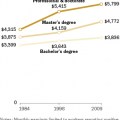
A new study shows that in many parts of the country parents are paying as much as 15% of the median family income for full-time infant care.
As the millennial generation enters its own with many striking out in the career world and creating families of their own, some are finding the costs of the latter are eating up the proceeds of the former.
Studies have shown that members of this generation are seeing as much as 15% of their income gobbled up by the rising costs of childcare.
To determine just how big of a chunk of income millennials, those born after 1980, are paying for childcare, Child Care Aware of America conducted a study across all 50 states.
The organization looked at the average costs of center-based care, including Head Start, license-exempt and school based programs, and state-funded pre-kindergarten programs.
Its findings were released recently, showing that in many parts of the country parents are paying as much as 15% of the median family income for full-time infant care.
Explaining the Rising Costs
A number of factors come into play that are forcing an increase in the average prices parents pay for full-time care, North Carolina-based Child Care Services Association explained.
The rising costs of food and rent, for example, are combining to help increase center overhead. Add to those costs the fact that there is a push on for more educated and better trained childcare workers and managers at centers are finding it difficult to keep up with growing payroll costs.
The lack of harmony between supply and demand has created what the Center for Study of Child Care Employment at the University of California at Berkeley calls a “broken market.”
“We now have sort of 21st century expectations and we still have, in some ways, a 20th century system,” the center’s director Marcy Whitebook said.
On average, married couples with an infant enrolled in full-time care are paying as much as 7 to 15% of their income for the service. Some couples report paying as much as $2,100 a month for childcare.
The cost of pre-school and nursery care for children age 5 and younger climbed by nearly 50% between 1990 and 2011, according to Arizona State University School of Public Affairs professor Chris Herbst. The figures were derived from Census Bureau data.
While some families are paying out a fortune in childcare, others are looking inward for less formal arrangements. The percentage of families obtaining childcare from relatives was 21% in 1990. The number climbed to 27% in 2011, Herbst’s research revealed.
The Ramifications
Researchers say the growing costs of childcare may have widespread economic repercussions as families scramble to make ends meet. As the millennial generation reaches prime child-bearing years, the demand for care is expected to continue to grow at a pace that will outstrip supply.
This, in turn, will continue to drive up costs at a rate that outpaces overall inflation. The overall impact is expected to include the inability for some parents to enter the workforce at all while others will find their ability to spend earnings on other services and goods limited by the bite childcare takes out of their budgets.





